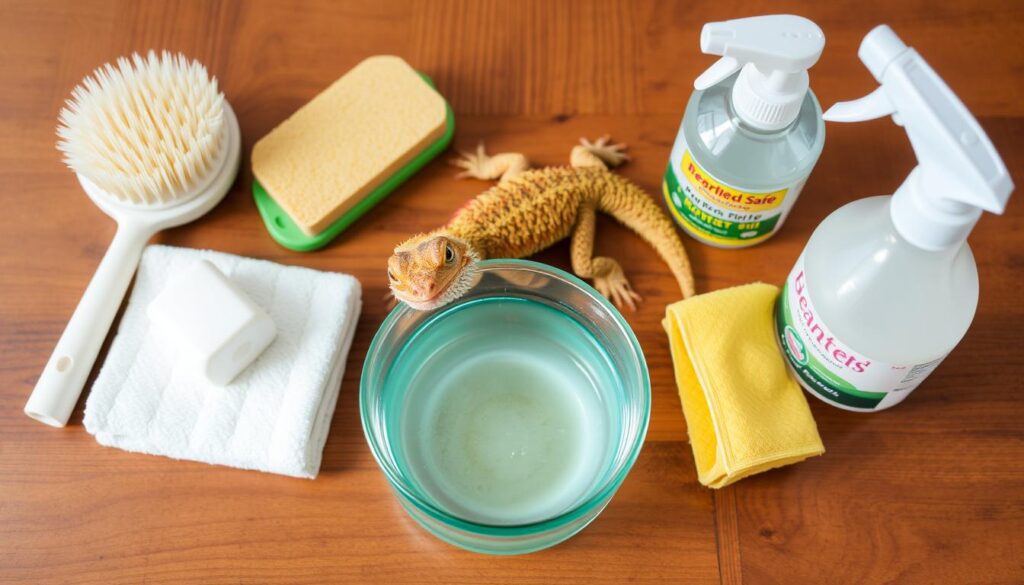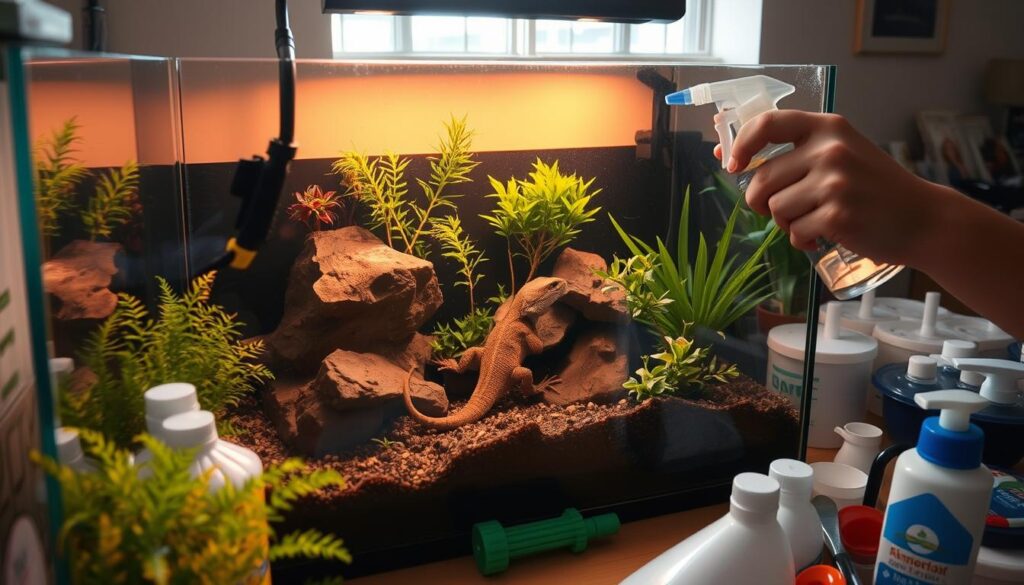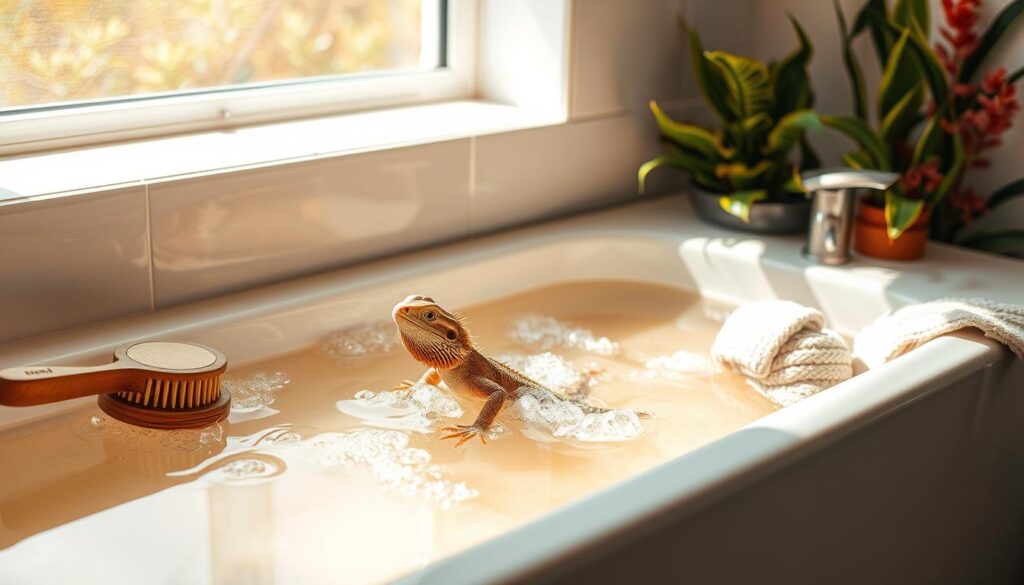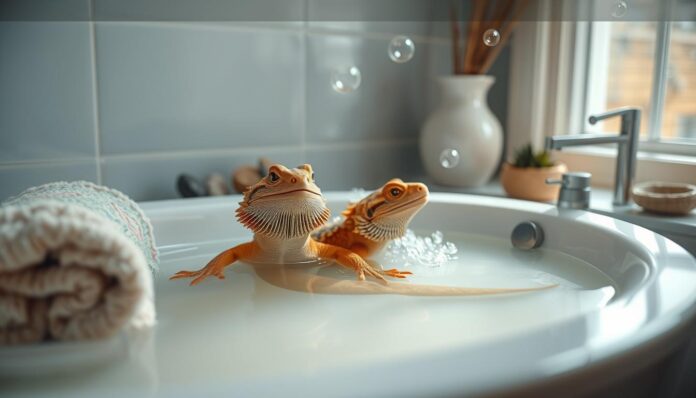How to Clean a Bearded Dragon?
Bearded dragons, those captivating lizards from central Australia, can live up to a remarkable 8-10 years with proper care. Keeping them healthy and long-lived requires careful attention to hygiene. It’s important to clean and sanitize their habitat well.
These reptiles are prone to respiratory infections. They can also pass Salmonella bacteria to their human caretakers.
This guide will show you how to keep your bearded dragon’s enclosure clean and healthy. You’ll learn about daily spot cleaning and monthly deep cleaning routines. These practices will help your scaly friend thrive for years.
Understanding Bearded Dragon Hygiene Basics
Keeping your bearded dragon clean is key to their health. These reptiles have sensitive lungs, making them prone to health problems from dirty environments. A clean space is vital to avoid many health issues.
Why Proper Hygiene is Essential
Bearded dragons face many health risks if their homes are not clean. Ignoring cleanliness can cause breathing problems, skin infections, and parasites. These issues can make your pet very uncomfortable and stressed, leading to serious health problems if not treated.
Health Risks of Poor Hygiene
- Tail rot: A bacterial infection that can cause the tail to decay and eventually fall off if not treated promptly.
- Stress-related diseases: Poor hygiene can contribute to heightened stress levels, making bearded dragons more susceptible to various illnesses.
- Loss of appetite: Overwhelming odors and unsanitary conditions in the enclosure can discourage bearded dragons from eating, leading to nutritional deficiencies.
Common Hygiene-Related Issues
Good hygiene is key to avoiding common problems like irritations, infections, and parasites. Keeping your bearded dragon’s space clean ensures they stay healthy and happy.
Essential Cleaning Supplies and Equipment
Keeping your bearded dragon’s environment clean is key for their health. You’ll need specific bearded dragon cleaning supplies and bearded dragon cleaning equipment for this. These items help you clean effectively and safely, for both you and your pet.
Start with personal protective gear like masks and gloves. They protect you from harmful bacteria. Also, have paper towels, cleaning cloths, and a strainer ready to remove waste from the enclosure.
For cleaning, white vinegar and F10SC veterinary disinfectant are great. They kill harmful germs and keep your pet’s home clean and healthy.
To keep the right temperature and humidity, use thermometers and a humidity gauge. A mister or spray bottle helps keep the air moist.
- Mask and gloves
- Paper towels and cleaning cloths
- Sieve or strainer
- White vinegar and F10SC disinfectant
- Thermometers and humidity gauge
- Mister or spray bottle
With the right bearded dragon cleaning supplies and bearded dragon cleaning equipment, you can keep your pet’s home clean. Cleaning regularly is vital to prevent sickness and keep your bearded dragon happy and healthy for a long time.

| Cleaning Supplies | Habitat Maintenance |
|---|---|
| Mask and gloves | Thermometers |
| Paper towels and cleaning cloths | Humidity gauge |
| Sieve or strainer | Mister or spray bottle |
| White vinegar and F10SC disinfectant | UV lighting fixtures |
How to Clean a Bearded Dragon Safely
Keeping your bearded dragon clean is vital for their health. Cleaning them safely means being gentle and following a careful process. This keeps the lizard comfortable and the habitat clean.
Proper Handling During Cleaning
When cleaning your bearded dragon, be gentle and avoid stressing them. Don’t make sudden moves or loud noises. This could scare the lizard.
Put the bearded dragon in a safe, small space like a cleaning tank or a towel-lined container. This keeps them from trying to escape while you clean.
Step-by-Step Cleaning Process
- First, check the bearded dragon’s enclosure for uneaten food, poop, and other debris. Remove it all.
- Use a reptile-safe cleaning solution or a mix of white vinegar and warm water. Clean all surfaces, like the tank walls, substrate, and decorations.
- Then, rinse everything well to get rid of any cleaning solution left behind.
- If needed, change the substrate to keep the environment fresh and clean for your bearded dragon.
Post-Cleaning Care
After cleaning, make sure the tank is dry before putting the bearded dragon back. Use a soft, absorbent towel to dry them off gently.
Once everything is dry, you can safely return the bearded dragon to their clean home.
By cleaning safely and regularly, you keep your bearded dragon healthy and happy. Cleaning prevents bacteria and parasites, keeping your pet safe and healthy for a long time.
Daily Maintenance and Spot Cleaning
Being a responsible bearded dragon owner means keeping their home clean every day. This daily cleaning routine is key to keeping your pet’s habitat clean. It also helps keep your bearded dragon healthy and happy.
Spot cleaning is a big part of caring for your bearded dragon daily. You need to remove any feces, uneaten food, or debris from the tank. Also, clean the feeding bowls with F10 disinfectant every day. This stops dirt and illness from building up.
Doing these small cleaning tasks every day helps keep your bearded dragon’s home clean. It also lowers the chance of them getting sick. This is a big part of keeping your pet healthy and happy for a long time.
Spot cleaning is easy and doesn’t stress out your bearded dragon. You can do it without taking them out of their home. This simple cleaning routine keeps their environment clean and safe.

Weekly Cleaning Routine for Bearded Dragons
Keeping your bearded dragon’s home clean is key for their health. Daily spot cleaning is important, but a deeper clean once a week is needed. This keeps their habitat in top shape.
Tank Sanitization Methods
First, take your bearded dragon out of their home. Mix equal parts white vinegar and warm water to clean all parts. This mix kills bacteria and stops harmful germs from growing.
Substrate Maintenance
Next, take out and replace the substrate. You might need to clean or change it based on what you use. Keeping the substrate clean is vital for your dragon’s health.
Accessory Cleaning
- Soak decorations, hides, and accessories in the vinegar-water mix.
- Scrub off any stuck-on dirt or algae.
- Then, rinse well and let them dry before putting them back in the bearded dragon tank.
This 30-minute weekly routine keeps your bearded dragon habitat clean. By doing this, you make sure your dragon’s home is safe and healthy.
Deep Cleaning Schedule and Procedures
Keeping your bearded dragon’s home clean is key to their health. Daily and weekly cleaning are important. But, deep cleaning is vital too. It should happen at least once a month to keep the habitat safe from harmful germs.
When deep cleaning, take your bearded dragon out for about two hours. You’ll need to clean everything in the habitat, like the tank, decorations, and substrate. Use a disinfectant like F10SC, made for reptile homes, to sanitize.
- Clean and disinfect the tank, decorations, and other items in the habitat.
- Put in a new, clean layer of substrate, making sure it’s about 3 inches deep.
- Use a steam cleaner to sanitize the enclosure’s surfaces. The heat can kill germs.
- For tough stains, use a mild bicarbonate of soda solution to gently scrub.
- Make sure all surfaces are dry before putting your bearded dragon back in their home.
By sticking to this deep cleaning schedule, you can keep your bearded dragon’s home clean and healthy. This helps prevent infections and keeps them happy and well.

Cleaning and Maintaining the Habitat Environment
Keeping the habitat clean is key for a bearded dragon’s health. The warm area should be between 95-110°F. The cool area should be 75-85°F. Humidity should be between 30-40%.
Temperature and Humidity Control
Bearded dragons need their environment to stay warm. They need a temperature range to stay healthy. Also, the right humidity helps prevent breathing problems and keeps their skin healthy.
UV Light Maintenance
UV light is important for bearded dragons to get calcium and vitamin D. Change the UVB light bulb every 6-12 months. Not doing this can cause serious health issues like metabolic bone disease.
Ventilation Requirements
Good air flow is vital to keep humidity down and prevent bacteria. Make sure the enclosure has enough air. Also, change the water dish daily to stop bacteria from growing.
By keeping an eye on temperature, humidity, UV light, and air flow, you can make a great home for your bearded dragon. A clean and comfy habitat is essential for their happiness and health.

Safe Cleaning Products and Solutions
Keeping your bearded dragon clean is key to their health. You need to use safe, reptile-friendly cleaners. There are a few top picks for bearded dragon safe cleaners.
The F10SC veterinary disinfectant is a top choice. It fights off many pathogens like bacteria, viruses, and fungi. It’s made for reptiles and is safe and reliable for cleaning your dragon’s home.
For a budget-friendly option, try a 1:1 mixture of white vinegar and water. It’s great for wiping down surfaces and cleaning accessories. Vinegar is natural and safe for reptiles.
Stay away from harsh chemicals and products not made for reptiles. They can harm your bearded dragon. Steam cleaning is also safe and effective. It kills bacteria and germs without harsh chemicals.
Using these safe cleaners in your bearded dragon’s care routine keeps their environment clean and healthy. This helps your scaly friend thrive.

Preventing Bacterial Growth and Disease
Keeping your bearded dragon’s home clean is key to stopping bacteria and diseases. Clean the enclosure often, manage the substrate well, and keep the temperature and humidity right. These steps help keep your pet healthy.
Common Sanitization Mistakes
Many pet owners use the wrong cleaners, which can harm their bearded dragons. Always choose safe, pet-friendly cleaners. Make sure to rinse the enclosure well to get rid of any leftover cleaner. Not drying the enclosure after cleaning can also lead to harmful bacteria.
Health Monitoring Tips
- Check your bearded dragon often for signs of sickness, like being tired, not eating, or weird poop.
- Keep an eye on the enclosure’s temperature and humidity. They should be just right for your bearded dragon’s health.
- Watch how your bearded dragon acts. Look for any changes that might mean they’re sick, like basking too much or hiding a lot.
- If you see any worrying signs or have health questions, talk to a vet who knows about reptiles.
By keeping things clean and watching your bearded dragon closely, you can stop bacteria and diseases. This helps your pet stay healthy for a long time.
Seasonal Cleaning Considerations
As owners of bearded dragons, it’s key to know how seasons affect their care and cleaning. These reptiles come from the Australian desert. Their needs change with the seasons.
Bearded dragon seasonal care means changing how often and how you clean their home. In the breeding season, they make more waste. So, you might need to clean more often. But in colder months, they’re less active, so you can clean less.
Seasonal changes also affect their UV light exposure. They need specific light to stay healthy. Adjusting UV light to match natural light cycles is important. This helps them regulate their body temperature and bask properly all year.
By understanding your bearded dragon’s seasonal needs, you can keep their home perfect. A flexible bearded dragon cleaning schedule supports their health and happiness. A clean habitat is vital for their long-term well-being.
Special Cleaning Situations for Sick or Shedding Dragons
Caring for a sick or shedding bearded dragon needs extra care. You must clean more often to keep things clean and stop infections. This is very important.
When your dragon is shedding, keeping the air moist is key. Create a “humidity hide” with wet sphagnum moss. This helps your dragon shed easily and safely.
- Increase cleaning frequency for sick bearded dragons to avoid additional stress
- Use gentle, stress-reducing cleaning methods for ill dragons
- Maintain proper humidity levels during shedding to facilitate the process
- Provide a humidity hide with moist sphagnum moss to assist with shedding
By following these special cleaning tips, you can help your sick or shedding dragon. This ensures their health and helps them recover or shed their skin well.

| Cleaning Situation | Recommended Approach |
|---|---|
| Sick Bearded Dragon | Increase cleaning frequency, use gentle methods to avoid additional stress |
| Shedding Bearded Dragon | Maintain proper humidity levels, provide a humidity hide with moist sphagnum moss |
Conclusion
Keeping bearded dragons clean is key to their health. Regular cleaning and disinfection are vital. They help prevent harmful bacteria and keep these pets well.
By sticking to a cleaning schedule and using the right products, owners can keep their bearded dragons safe. Watching for health problems is also important. This way, they can live in a clean, comfy space.
Temperature and humidity control are also critical. They help these reptiles stay healthy and thrive. In short, bearded dragon hygiene importance is huge. A good bearded dragon care summary covers cleaning and habitat care well. Following these tips will help your bearded dragon live a long, happy life.
FAQ
What are the essential cleaning supplies for a bearded dragon?
You’ll need a mask, gloves, and paper towels for cleaning. Also, a sieve, cleaning cloths, white vinegar, and F10SC veterinary disinfectant. For the habitat, get thermometers, a humidity gauge, a mister, and UV lighting.
How often should a bearded dragon be bathed or cleaned?
Clean the enclosure daily by removing waste and uneaten food. Weekly, do a deeper clean that takes about 30 minutes. Monthly, do a deep clean that takes about two hours.
What are the health risks of poor hygiene for bearded dragons?
Poor hygiene can cause irritations, infections, and parasites. Issues like tail rot and stress diseases can occur. Keeping the enclosure clean is key to your dragon’s health.
How can you safely clean a bearded dragon?
Clean your dragon safely by handling them gently. Remove them from their home, clean with the right solutions, and rinse well. Dry them completely and make sure the enclosure is clean before returning them.
What are the best cleaning products for bearded dragons?
Use F10SC veterinary disinfectant and a white vinegar and water mix. Avoid harsh chemicals and reptile-specific products. Steam cleaning is also safe and effective.
How can you prevent bacterial growth in a bearded dragon’s habitat?
Keep the habitat clean, manage the substrate, and control temperature and humidity. Avoid using the wrong cleaning products and ensure the enclosure is dry. Watch for signs of illness in your dragon.
How do you clean a bearded dragon during shedding or illness?
Clean more often and gently when your dragon is sick or shedding. Keep humidity right and provide a moist hide for shedding.


